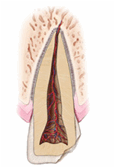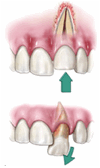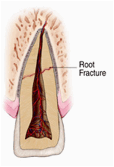|
How will my
injury be treated?
Chipped teeth account for the
majority of all dental injuries.
Avulsed or knocked-out teeth are
examples of less frequent, but
more severe injuries. Treatment
depends on the type, location and
severity of each injury and the
development stage of the tooth.
Any dental injury, even if
apparently mild, requires
examination by a dentist
immediately. Sometimes,
neighbouring teeth suffer an
additional, unnoticed injury that
will only be detected by a
thorough dental exam or may only
be detectable when problems arise
much later.
|
Chipped
or Fractured Teeth
|
 |
Most chipped
or fractured tooth crowns
can be repaired either by
reattaching the broken
piece or by placing a
tooth-coloured filling. If
a large portion of the
tooth is broken off, more
extensive work may be
required on the tooth.
If the pulp tissue is
exposed or damaged after a
crown fracture, root canal
treatment may be needed. |
|
Dislogded
(Luxated) Teeth
|
 |
During an
injury, a tooth may be
pushed sideways, out of or
into its socket. The tooth
will need to be
repositioned. The extent
of the damage to the
supporting tissues of the
teeth will determine
whether or not root canal
treatment is required and
we would take a
conservative approach as
oftentimes the tooth will
heal without the need for
root canal treatment. It
is more damaging to the
tooth when the tooth is
pushed upwards into the
socket as opposed to
pulled slightly downwards
as it causes a crushing
injury to the supporting
tissues. It is better for
the supporting tissues to
be stretched rather than
crushed.
Childrenís teeth are more
likely to heal than adults
teeth but when they donít
heal the damage is worse
as the teeth are not fully
developed. Careful
monitoring is required.
Again we would take a
conservative approach.
Multiple follow-up
appointments are likely to
be needed.
|
|
Knocked-Out
(Avulsed) Teeth
|
|


|
If a tooth is
completely knocked out of
your mouth, time is of the
essence. The tooth should
be handled very gently,
avoiding touching the root
surface itself. If it is
dirty, quickly and gently
rinse it in water. Do not
use soap or any other
cleaning agent, and never
scrape or brush the tooth.
If possible, the tooth
should be placed back into
its socket as soon as
possible. The less time
the tooth is out of its
socket, the better the
chance for saving it. Call
your dentist immediately!
The golden time is 45
minutes, if you can
reposition the tooth
within 45 minutes, quicker
if possible then your
chances of saving the
tooth are much higher.
If you cannot put the
tooth back in its socket,
it needs to be kept moist,
ideally in saliva (between
the gum and cheek) or
milk. It is not advisable
for a child to put the
tooth between their gum
and cheek as they could
swallow the tooth. But an
adult can safely keep the
tooth there. Do not place
the tooth in regular tap
water because the root
surface cells do not
tolerate it.
Once the tooth has been
put back in its socket,
your dentist will evaluate
it and will check for any
other dental and facial
injuries. If the tooth has
not been placed back into
its socket, it will be
cleaned and carefully
replaced. A stabilizing
splint will be placed for
a few weeks. Depending on
the stage of root
development, your dentist
or endodontist may start
root canal treatment a
week or two later. A
medication may be placed
inside the tooth followed
by a permanent root canal
filling at a later date.
The length of time the
tooth was out of the mouth
and the way the tooth was
stored before reaching the
dentist influence the
chances of saving the
tooth. Again, immediate
treatment is essential.
Taking all these factors
into account, your dentist
or endodontist may discuss
other treatment options
with you. |
|
Root
Fractures
|
|

|
A traumatic
injury to the tooth may
also result in a
horizontal root fracture.
The location of the
fracture determines the
long-term health of the
tooth. If the fracture is
close to the root tip, the
chances for success are
much better. However, the
closer the fracture is to
the gum line, the poorer
the long-term success
rate. Sometimes,
stabilization with a
splint is required for a
period of time.
|
|
Do
traumatic dental
injuries differ in
children?
|
|

|
Chipped baby
teeth can be restored.
Dislodged primary teeth
can, in rare cases, be
repositioned. However,
primary teeth that have
been knocked out typically
should not be replanted.
This is because the
replantation of a
knocked-out primary tooth
may cause further and
permanent damage to the
underlying permanent tooth
that is growing inside the
bone.
Childrenís permanent teeth
that are not fully
developed at the time of
the injury need special
attention and careful
follow up, but not all of
them will need root canal
treatment. In an immature
permanent tooth, the blood
supply to the tooth and
the presence of stem cells
in the region may enable
your dentist, paediatric
dentist or endodontist to
stimulate continued root
growth.
Endodontists have the
knowledge and skill to
treat incompletely formed
roots in children so that,
in some instances, the
roots can continue to
develop. We will do all
that is possible to save
the natural tooth.
|
Will the
tooth need any special care or
additional treatment?
The nature of the injury, the
length of time from injury to
treatment, how your tooth was
cared for after the injury and
your bodyís response all affect
the long-term health of the tooth.
Timely treatment is particularly
important with dislodged or
knocked-out teeth in order to
prevent root resorption.
Resorption occurs when your body,
through its own defence
mechanisms, begins to reject your
own tooth in response to the
traumatic injury. Following the
injury, you should return to your
dentist or endodontist to have the
tooth examined and/or treated at
regular intervals for up to five
years to ensure that root
resorption is not occurring and
that surrounding tissues continue
to heal. There are different types
of resorption. It has to be noted
that some types of resorption are
untreatable. Digital radiographs
are excellent for assessing for
resorption.
|
|